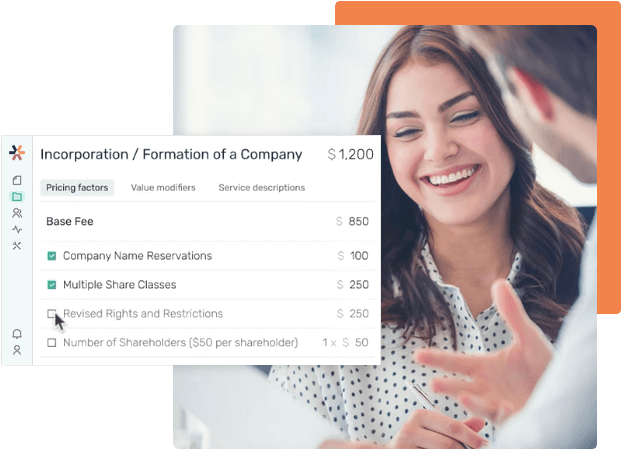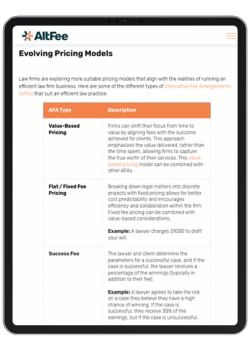- Resources
- Top 3 Law Firm Pricing Strategies to Implement in 2022
Table of Contents
Economic and social factors have been pushing the legal industry to rethink the way it handles pricing.
Digitization alongside the demand for price certainty and transparency from clients has strongly encouraged law firms to move away from traditional pricing models and look into new and revolutionary ways to price their legal services.
These new pricing models dubbed alternative fee arrangements, or AFAs, also support a better work-life balance for lawyers, something that has been causing mass resignations of the top talent in law firms, and even some lawyers leaving the profession altogether.
But as law firms move away from traditional hourly pricing, there are still questions surrounding what the best alternative pricing solutions are and how law firms can easily implement and manage a law firm pricing solution that works for them.
Law firm pricing is a huge topic, but this article provides the background and reasoning behind why you should change your law firm’s pricing structure, along with suggested models, tools, and strategies to make the switch easier for legal professionals.
What is Law Firm Pricing?
Law firm pricing refers to the specific method that a law firm uses to charge for legal services provided to its clients. Common pricing methods include billing by the hour and a variety of alternative fee arrangement types.
Timesheets weren’t always a thing in the legal industry. Neither was billing by the hour. In fact, before the 1960s, value-based pricing was common, where lawyers would charge clients based on their experience of how long a job would take to complete, how much competitors were charging, how much work and effort the job would require, and more. In other words, pricing was based on perceived value rather than straight time.
Besides, in the United States up until around the mid-1900s, legal fees were capped at a certain amount depending on the service, and in cases where litigation was taken, the losing party was typically responsible for paying all the fees.
So why did the billable hour become a thing for law firms?
Some sources suggest that it was because lawyers wanted to make more money as being the main reason, alongside deregulation (those state laws capping legal services that we were talking about? Gone). The sources also say, interestingly, that clients wanted more transparency in the way that lawyers priced their services as well.
Whether the last point is due to the lawyers in that time period simply overcharging for simpler services or not properly embracing the idea of a perceived value-based pricing model is unclear, but regardless, lawyers started tracking every minute of their day and by the 1960s, the billable hour was pretty much the new standard for law firms.
But when you fast forward to the 21st Century, the now traditional way of billing by the hour is increasingly being questioned by both legal professionals and their clients.
Transparency Over Law Firm Fees and Pricing
On the surface, billing by the hour seems to make sense — you tell the client how much you charge per hour, and when the work is done, you give them an invoice detailing what you did and how long it took. It’s not difficult for clients to understand, and it’s easy to say that you’ll only bill clients for the amount of time you took to complete a project, and nothing more.
But the traditional hourly billing model comes rife with problems related to price transparency:
- It assigns value to time instead of a quality product
- It relies on the lawyer accurately tracking their time (often in 6 minute increments)
- It doesn’t give the client an accurate measure upfront of how much a legal service will cost
Lawyers have been sharing their experiences and frustrations with time tracking for a while, pointing out that it’s not only time-consuming and annoying to do, but that it shifts the focus from the quality of work performed to the amount of time it took and encourages lawyers to fudge the numbers in their favor. Not saying that every lawyer is making up how much time they spend on a project, but think about it: how accurate is time tracking, really? Unless you’re literally timing yourself with a stopwatch, chances are you’re giving a ballpark estimate rather than a completely accurate number.
In addition, it’s hard for a client to know what the final cost of legal service will be when a law firm uses the hourly model for billing. Sure, the lawyer might be able to give you an estimate for a more straightforward task, but in more complex cases, like family matters or litigation, it is way more difficult to estimate a final cost if a straight hourly billing model is used.
And price transparency is really what clients are looking for. According to a recent Clio legal trends report:
“78% of consumers say that lawyers should adopt pricing or payment models that will make legal services more affordable.”
One caveat though is that their definition of “affordability” is based more on how they perceive the value of the services they provide, rather than simply wanting them to be cheaper.
Many have cited the pandemic as a catalyst for an increased push for law firms to adopt more transparent pricing models, as it has led to a marked change in economic and social factors around the world, or at least highlighted them further. But one thing is for certain — client expectations have changed. A more tech-savvy audience (remember: Millennials are now all adults), increased willingness to research, and an overall focus on more careful spending demand that law firms provide transparent pricing at every step of client interaction.
If clients could have cost certainty with their legal fees from the start, it would almost assuredly solve many of the problems with legal accessibility and perception of legal costs. One of the ways this can be accomplished is through AFAs.
How do AFAs Provide Price Certainty?
AFAs in general offer more transparency over law firm fees and pricing through increased predictability with what a final legal bill will look like for a client, even with more complex files.
Let’s illustrate how AFAs provide cost certainty with a couple of examples.
Let’s say a client wants a legal service with a clear scope, like drafting a Last Will and Testament or another legal document. With an AFA model, this would likely be billed via a flat fee, which would be based on a combination of the actual labor that goes into creating the document, current market rates, and the value that the client receives (based on the lawyer's experience). In this way, the AFA provides a more straightforward pricing structure, ultimately providing the client with peace of mind knowing what the final cost of the project will be in advance.
For more complex projects, like let’s say a litigation case, a staged-based or phase-based AFA approach could be used, as an example. With this type of fee structure, the client pays a set fee for each phase of a project, which often helps with the accuracy of budgeting and forecasting fees. It gives the client a breakdown of the work to be performed in each phase and helps them understand the overall reasoning behind certain fees rather than giving them one flat rate for the whole project.
4 Types of Legal Pricing Tools
Setting out your law firm’s pricing strategy requires the use of the correct tool for the job. There are a variety of law firm pricing tools out there, all with different benefits and drawbacks.
Let’s take a closer look at some legal pricing tools that law firms use every day, or are new entrants into the law firm pricing market:
Microsoft Excel
Now we’re not saying that Excel isn’t a great tool in general, but for managing your law firm pricing? It’s not the best, that’s for sure. Things can quickly get out of hand with stakeholders making untracked changes to pricing structures, creating multiple versions of one spreadsheet, and, well, you get the point. If you have a really simple law firm pricing strategy, you might be able to get away with using Excel as a simple law firm pricing tool. As soon as you hire more lawyers and grow in size? Not so much.
AltFee
Simply moving to an AFA model without a way to manage it effectively isn’t a solution. AltFee is a law firm pricing tool that you can use to manage multiple pricing strategies for different matters with ease, with the added benefit of built-in collaboration. Instead of having to look at email or messaging to collaborate with colleagues, stakeholders can leave comments and feedback for specific projects quickly and easily.
This allows you to fine-tune your pricing over time and confidently present your pricing structure to clients.
Start Earning More Revenue with Fixed Fees
Break free from hourly pricing and take the fear out of scoping and pricing client projects to start maximizing profitability.
Book A Demo
Legal.io Legal Pricing Tool
Law firm pricing transparency is such a big issue in the legal market that online tools have popped up that show hourly rates and salary data in different practice areas and markets. Legal.io’s pricing tool is one of them. Through this tool, you can input a US city and practice type, and it will return low, average, and high rates for lawyers in that area based on the Legal.io community’s input. The tool doesn’t tell you the specific prices of different law firms, rather it gives you a rough range so clients have a better idea of what to expect. It will also show a graph that attempts to align experience level with price, so potential clients can see if a higher price tag gives them more value for the legal services they’re seeking.
While tools like Legal.io’s pricing tool do provide some price transparency, if anything it just gives further evidence that more law firms need to adapt to a more accessible, transparent pricing structure to win client trust.
Complimentary Suggestion -Clio Manage
A practice management tool like Clio Manage allows you to manage the back-end processes of time tracking, taking payments, case management, and document storage. They typically have compatibility with software like Outlook and the Google Suite built-in making them complementary software to the legal pricing tools noted above.
You’ll still need a collaborative and straightforward pricing tool, like AltFee, but having a tool to additionally organize billable work and back-end billing processes makes for a complete software solution to lift your legal firm from the stone age.
Common Law Firm Pricing Models
There are virtually limitless ways in which you can price your legal services, but the majority of law firms follow a pricing model that resembles the ones, or combination of the ones, discussed below:
Hourly Rate
Often referred to as traditional pricing or the hourly billing model, this is typically the default law firm pricing strategy. A lawyer charges an hourly rate based on the type of case and their experience level. While it’s a simple pricing structure, it causes a lot of uncertainty from the get-go with the client — it’s difficult for the lawyer to know exactly how long your case will take them to handle, so total costs are often up in the air.
Subscription-Based or Periodic Fee
Some law firms use a subscription-based model for their pricing, similar to a SaaS company like Netflix or Spotify. The client pays a monthly fee in exchange for a set legal service or combination of services through a predetermined plan. For instance, a real estate business owner could pay for a subscription for a lawyer to manage the legal side of housing purchases on an ongoing basis.
Fixed Fee or Flat Fee
A fixed or flat fee structure is probably the simplest type of legal fee: the lawyer tells you how much it is in advance and you pay it. This type of fee is often reserved for projects where you can accurately scope the amount of work upfront.
Capped Fee
A capped fee means that a client won’t be charged over and above a certain amount for a legal service. Usually capped fees also come with a minimum fee, meaning the client will have to pay at least the minimum fee for their service.
Portfolio Fixed Fee
A portfolio fixed fee sets out a predetermined price for a bundle of legal matters. This type of fee is typically charged to large corporations that have a number of legal matters that need to be handled at one time, like legal disputes, purchasing, and more.
Success Fee
With a success fee, the client agrees to pay an amount over and above the original agreed-upon fee if certain conditions are met, i.e. the lawyer wins the case. This type of fee typically needs a Conditional Fee Agreement (CFA) to be outlined in advance to determine what “success” means for both the lawyer and client.
Phased Fee (or Staged Fee)
With a phased fee, a total legal matter is broken down into stages, and the client pays a set fee when each stage is completed. Each stage might have the same fee or different fees, depending on the scope of the legal matter.
Contingency Fee
With a contingency fee, the client is typically only responsible for paying their legal fees if the desired result is met, i.e. the lawyer wins the case. The contingency fee is typically set out in advance as a percentage and is used in cases where monetary compensation is expected with the successful outcome of the case.
Modern-Day Law Firm Pricing Strategies (Value-Based)
Modern-day law firms often focus on a “client first” approach to their legal pricing strategy. Developing this client-first pricing approach often includes asking the client targeted questions about pricing and budgets, as well as looking at ways that the firm itself can improve efficiency with task execution. This approach often leads a law firm to adopt some sort of an alternative fee pricing structure.
The most common law firm pricing strategies can be summarized as follows:
Cost-Based Pricing
Also sometimes referred to as a cost-plus pricing model, this pricing approach charges clients based on the costs required to perform a legal matter, plus a profit margin (e.g. a lawyer’s hourly rate plus a base law firm fee).
Competition-Based Pricing
This pricing strategy looks at what other competing law firms are charging and sets out a price based on what these firms charge.
Customer Value-Based Pricing
As a more client-focused legal pricing strategy, customer value-based pricing is the result of a variety of factors such as collaboration between legal professionals, typical market rates, legal matter types, and more.
Developing Your Law Firm’s Pricing Strategy
When you’re developing your pricing strategy, it’s important to have a complete understanding of what your client is looking for with your legal services. This means asking clients what they want and using that information to influence what your law firm's pricing strategy will ultimately look like. Most industries measure client satisfaction in some form, and consider it an important KPI with regards to getting an idea of the overall conversation surrounding their business and products, so why not legal?
In addition, according to the 2022 State of Legal Report from Thomson Reuters, the pandemic thrust two major issues with law firms into the spotlight: the demand for more work-life balance from lawyers, and more transparency with pricing from clients. AFAs are outlined as one of the ways that law firms can succeed with both. AFAs can also help you scale your revenue upwards.
Law Firm Pricing Success Stories
By using alternative fee arrangements and more client-focused legal pricing strategies, these law firms were able to see major success.
DL&Co.
After a move to an alternative fee arrangement pricing structure, this 25-person law firm was looking for a way where all their employees could collaborate on pricing client projects.
While AFA pricing was working, after about a year with the new pricing structure DL&Co realized that they needed a more efficient, centralized, and collaborative solution over manually managing their pricing. Enter AltFee. As a collaborative, scalable, and easy-to-use tool, AltFee provided an efficient and effective way for the firm to manage its pricing and meet its client-first values.
After using the software for two years, realization rates went up 11% (from 89% previously to 100% in total) — meaning that they were getting paid amounts equal to all of the hours worked on client files.
DL&Co also noticed some other benefits, namely that team members are more confident when it comes to pricing and taking the lead on client projects, and clients are more satisfied in general.
Reed Smith Global Solutions
As a law firm that provides innovative legal solutions for its clients, Reed Smith Global Solutions often positions AFAs as a way for their clients to re-evaluate their legal processes. They take a close look at the way that their clients handle legal matters, and offer ways to simplify complex tasks and optimize and improve processes.
One client they helped is a pharmaceutical company that prepares and manages a large number of research and development contracts for major clinical trials every single month. They needed a way to optimize the workload, reduce spending, and enhance collaboration to make the process of executing contracts easier.
The solution was offering a fixed monthly fee for all work (since it’s recurring) and specific negotiation positions for Reed Smith staff to handle if volume increases were necessary, along with providing resources for quick legal reviews and continuous improvements and refinements to all legal processes and technology.
The pharmaceutical company now enjoys increased efficiency on multiple fronts: access to client contracts reduces inquiries, and the fixed fee arrangement significantly reduces contact turnaround times.
Conclusion
In recent years, law firm pricing has come into question. Clients are demanding more transparency with total costs, and lawyers are rejecting the endless grind that’s been typical of the profession. The traditional hourly pricing model is increasingly no longer able to hold itself as the main go-to for law firm pricing. Instead, more and more firms are seeking out alternative fee arrangements to provide more cost transparency for their clients and save the sanity of their legal professionals.
It’s clear that AFAs are revolutionizing the legal industry. But in order to effectively create and manage an AFA law firm pricing strategy, you’ll need software to help you out. See AltFee in action and request a demo today.
Start Earning More Revenue with Fixed Fees
Break free from hourly pricing and take the fear out of scoping and pricing client projects to start maximizing profitability.
Book A Demo







Newsletter Signup
Subscribe to our newsletter to receive the latest news.



